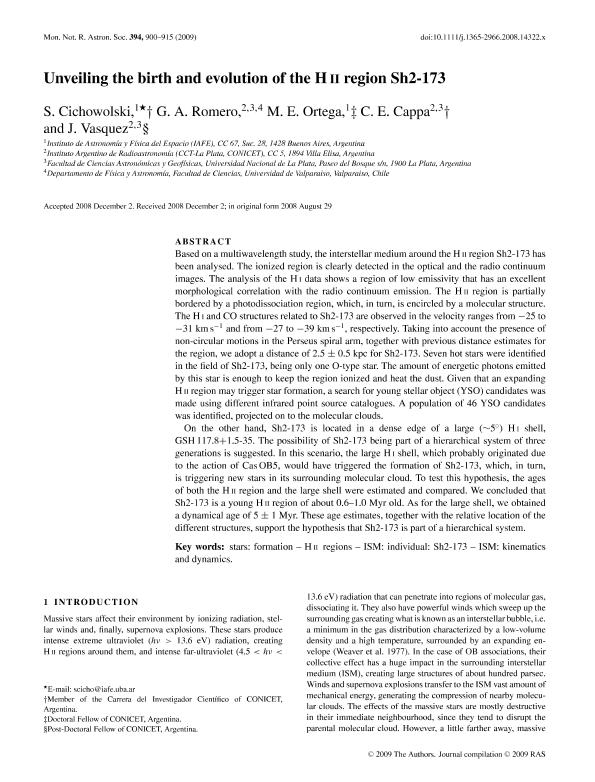Artículo
Unveiling the birth and evolution of the HII region Sh2-173
Cichowolski, Silvina ; Romero, Gisela Andrea
; Romero, Gisela Andrea ; Ortega, Martin Eduardo
; Ortega, Martin Eduardo ; Cappa, Cristina Elisabeth
; Cappa, Cristina Elisabeth ; Vasquez, J.
; Vasquez, J.
 ; Romero, Gisela Andrea
; Romero, Gisela Andrea ; Ortega, Martin Eduardo
; Ortega, Martin Eduardo ; Cappa, Cristina Elisabeth
; Cappa, Cristina Elisabeth ; Vasquez, J.
; Vasquez, J.
Fecha de publicación:
04/2009
Editorial:
Oxford University Press
Revista:
Monthly Notices of the Royal Astronomical Society
ISSN:
0035-8711
Idioma:
Inglés
Tipo de recurso:
Artículo publicado
Clasificación temática:
Resumen
Based on a multiwavelength study, the interstellar medium around the H II region Sh2-173 has been analysed. The ionized region is clearly detected in the optical and the radio continuum images. The analysis of the H I data shows a region of low emissivity that has an excellent morphological correlation with the radio continuum emission. The H II region is partially bordered by a photodissociation region, which, in turn, is encircled by a molecular structure. The H I and CO structures related to Sh2-173 are observed in the velocity ranges from −25 to −31 km s−1 and from −27 to −39 km s−1, respectively. Taking into account the presence of non-circular motions in the Perseus spiral arm, together with previous distance estimates for
the region, we adopt a distance of 2.5 ± 0.5 kpc for Sh2-173. Seven hot stars were identified in the field of Sh2-173, being only one O-type star. The amount of energetic photons emitted by this star is enough to keep the region ionized and heat the dust. Given that an expanding H II region may trigger star formation, a search for young stellar object (YSO) candidates was made using different infrared point source catalogues. A population of 46 YSO candidates was identified, projected on to the molecular clouds. On the other hand, Sh2-173 is located in a dense edge of a large (∼5◦) H I shell, GSH 117.8+1.5-35. The possibility of Sh2-173 being part of a hierarchical system of three generations is suggested. In this scenario, the large H I shell, which probably originated due to the action of Cas OB5, would have triggered the formation of Sh2-173, which, in turn, is triggering new stars in its surrounding molecular cloud. To test this hypothesis, the ages
of both the H II region and the large shell were estimated and compared. We concluded that Sh2-173 is a young H II region of about 0.6–1.0 Myr old. As for the large shell, we obtained a dynamical age of 5 ± 1 Myr. These age estimates, together with the relative location of the different structures, support the hypothesis that Sh2-173 is part of a hierarchical system.
Archivos asociados
Licencia
Identificadores
Colecciones
Articulos(IAFE)
Articulos de INST.DE ASTRONOMIA Y FISICA DEL ESPACIO(I)
Articulos de INST.DE ASTRONOMIA Y FISICA DEL ESPACIO(I)
Articulos(IAR)
Articulos de INST.ARG.DE RADIOASTRONOMIA (I)
Articulos de INST.ARG.DE RADIOASTRONOMIA (I)
Citación
Cichowolski, Silvina; Romero, Gisela Andrea; Ortega, Martin Eduardo; Cappa, Cristina Elisabeth; Vasquez, J.; Unveiling the birth and evolution of the HII region Sh2-173; Oxford University Press; Monthly Notices of the Royal Astronomical Society; 394; 2; 4-2009; 900-915
Compartir
Altmétricas



